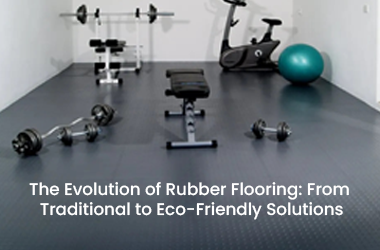
Rubber flooring has been the floor of choice in such places as gyms, schools and factories for many years. It has a reputation for making not only durable, but pierce- and wear-resistant also, it is simple and safe to clean. Yet everything else seems to be the same, except for the rubber flooring, which has also been adjusted and advanced in line with changes. Check the development of rubber flooring from the stone age of time to the contemporary biodegradable products we witness now.
Traditional Rubber Flooring
Rubber flooring not a long time ago was traditionally made from rubber that originated from the sap of the rubber trees. This kind of floor was reliable and durable. For this reason, it is leaned towards high traffic places, such as education facilities or work areas where safety was a priority. Nevertheless, natural rubber flooring had disadvantages. It was expensive and in some cases, the rubber that was sourced from trees was not harvested in an eco-friendly way.
Also, as the industry expanded, the tendency was to turn to synthetic rubber production. Synthetic rubber, in contrast to natural rubber, is made from chemicals, therefore, its cost becomes lower and its application becomes more extensive. Synthetic rubber flooring shared the same advantages as natural flooring, such as durability and slip-resistance, but at the same time, it had some ecological issues. The production process was designed to be dangerous to the environment, but the floor’s material became biodegradable.
The Rise of Recycled Rubber Flooring
The recent rise in environmental awareness has fostered research on alternative flooring materials. Thus, the production of recycled flooring arises. This is a kind of flooring that comes from the old tires and other rubber products will otherwise go to landfills. By doing this, rubber recycling, they could keep the lower rate of waste and gain the product which is still strong and frictional.
The introduction of flooring made from recycled rubber has become very popular within the past years. As it was of both the quality and the eco-friendliness. It is frequently used in gymnasiums, playgrounds, and even in cozy homes. Nevertheless, it is also made with recycled materials which make it priced less expensively.
Eco-Friendly Rubber Flooring Solutions
Today, it is not just recycling that is important, rather, it is about the production of flooring that is being thought of from the first to the last. The green approach to it includes the use of rubber from the sustainably. Managed forests and reducing the number of harmful chemicals in the production process. Some options are fully recyclable since the eco-friendly rubber flooring. Is also designed to be recycled to a new product instead of being disposed of.
Another exciting development is the use of bio-based flooring. This type of flooring is made from renewable resources like plant oils and natural resins. It’s a newer option on the market. But it shows promise as an even greener alternative to traditional flooring.
Conclusion
Flooring has come a long way from its early days. While traditional was durable and effective. Newer options are designed with the environment in mind. Recycled and eco-friendly flooring solutions offer the same benefits as older types but with a much smaller environmental impact. As more people and businesses look for sustainable options. It’s likely that we’ll continue to see innovations in flooring that make it even greener and more effective.


